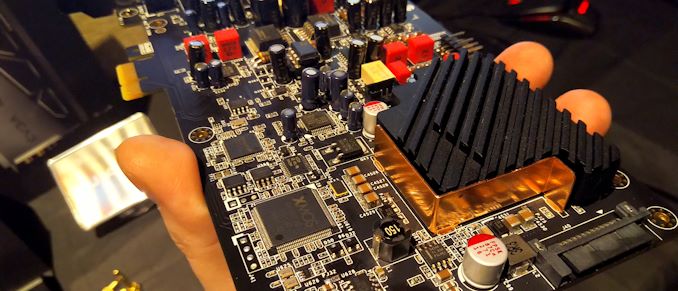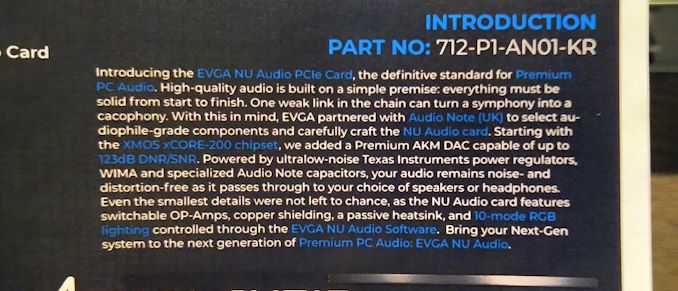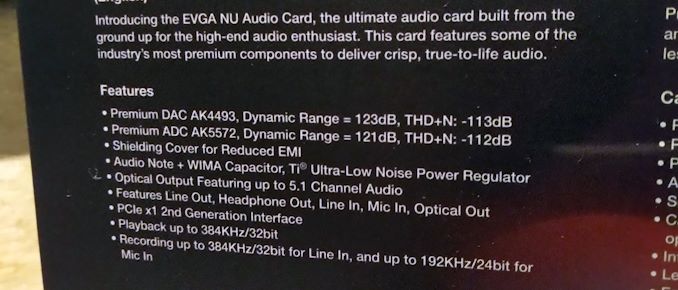EVGA Launches Its First Audio Card, the Nu Audio
by Ian Cutress & Anton Shilov on January 22, 2019 1:00 PM EST- Posted in
- Audio
- EVGA
- Trade Shows
- NU Audio
- CES 2019
- Audio Note

EVGA currently sells a range of products: motherboards, graphics cards, power supplies, cases, and laptops. EVGA has been expanding to other markets for a number of years now, and at CES 2016 we saw the beginnings of a USB audio device due to a collaboration with a professional company called Audio Note. We were impressed at the time, but since then we've not heard much about the project, and had kind of assumed it had been abandoned. But at CES 2019 EVGA introduced the results of the collaboration: its first audio card. This card uses a PCIe to USB controller, making it an internal USB audio product.
EVGA’s Nu Audio card was designed by Audio Note, a UK-based company that develops custom audio solutions. The PCIe 2.0 x1 card implements a PCIe to USB controller to the hardware, and is based on the XMOS xCORE-200 DSP accompanied by Asahi Kasei Microdevices’ (AKM) AK4493 DAC, the AKM AK5572 ADC, and the Cirrus Logic CS5346 ADC. The board uses a silver and gold-plated multilayer PCB with isolated dual ground planes for analogue and digital circuits. Being aimed at users who want a cleaner sound but also better sound support out of their audio outputs, the Nu Audio card uses audio-grade capacitors and resistors that carry Audio Note, Nichicon, WIMA, and Panasonic brands. Besides, it features switchable OP amps as well as a dedicated Maxim amp for headphone volume control.
The Nu Audio card is equipped with two RCA line outs for left and right speakers that can output 384 KHz at 32-bit audio, one output for headphones featuring impedance between 16 and 600 Ohms, an S/PDIF out, a line in supporting 384 KHz at 32-bit audio, and a mic in supporting 192 KHz at 24-bit audio. In addition to traditional analogue and digital outputs, the card supports USB audio class 2.0 enabled by the ASMedia ASM1042 PCIe-to-USB bridge. Meanwhile, to ensure that the board gets enough power, it has a SATA power connector coupled with a multi-stage VRM.
Since EVGA usually targets enthusiasts, its audio card is not only outfitted with a cooling system for heating components, but it is covered by a shroud featuring 10-mode RGB lighting as well as four Audio Reactive Lighting options that match the board’s lighting and audio. The bundled software allows for full EQ tuning, as well as a dynamic response implementation. With the right software, the audio card can support full audiophile formats, such as DSD, and switch between them as required.
EVGA is now currently selling the card, at a price of $249. This is the first in a line of cards, we were told - depending on the feedback of the hardware, the collaboration with Audio Note might extend into a gaming focused design or a more professional audio input/output design.
Related Reading
- EVGA Launches B360 Micro Gaming: Its First Budget Motherboard
- EVGA Releases CLC120 CL11 AIO CPU Cooler: Simple and Affordable
- EVGA Launches SC17 1080 Laptop: Core i7-7820HK, GeForce GTX 1080, TB3
- EVGA Torq X10 Gaming Mouse Review
Source: EVGA
















83 Comments
View All Comments
Kirby64 - Friday, January 25, 2019 - link
I think we may actually be more in agreement than not in terms of actual hardware info - we're just approaching this from different lenses. I care about full systems here and what the marketing wank numbers actually mean to my audio quality. What the chips do internally is often times hidden from users. Using a delta-sig (that internally does over-sampling) to achieve a better bit depth as a result is fine by me. It's just a means to an end. My point being that the label of 24 bit or 384kHz sampling (or even 192kHz sampling) is definitively not a label that must mean 'good audio quality'. There's a ton of other factors at play. Usually the fact that my audio doesn't have a bunch of interference from nearby noise sources plays a bigger role than all this other nonsense.That being said, any single audio DAC chip won't look like a stair step on the actual output due to inherent limitations of slew rate/high freq attenuation internally. Also, any audio chip you buy worth it's salt is going to have filtering already built into it. Most seem to quote at least 100dB of attenuation at ~0.45*Fs.
Also, not sure about your point on sampling? Where did I say you can't use the entire channel bandwidth? My only point is that non-periodic signals (to be 'truly' represented) effectively need infinite bandwidth to represent. Sure, after only a short period of time, the need for the extra bandwidth is lost in noise, but if we live in the perfect world (where DACs have nice sharp edges on their stair step output) then you need infinite bandwidth.
Also, it's definitely not cheaper to get good performance out of a higher bit depth DAC. Silicon costs money, full stop. If you can design a DAC that performs just fine with 16-bits and lower sampling rate, that is going to cost less. Unless you mean engineering investment to actually construct that device... then maybe there's a tradeoff.
Lastly, I think we'll have to agree to disagree on 16-bit vs. 24-bit usefulness for listening though. Same can be said of emphasis additions. There's plenty of tests that show people can't tell the difference between 16-bit and 24-bit well constructed audio.
mode_13h - Friday, January 25, 2019 - link
I agree that sample rate and bit depth cannot be used as a simple proxy for the audio quality of a device.Second, I figured most audio DACs have built-in analog filtering, for probably a long time now. Probably also oversampling, as well. That doesn't make my point invalid, as I'm concerned with the burden sample rate places on the design and performance of the analog output filter - whether or not it's integrated.
My point about periodic vs. non-periodic signals is that adding more bandwidth should allow more headroom to handle the transients other aspects where audio signals behave differently than truly periodic waveforms. I think 96 kHz should provide plenty of margin.
I never said that a DAC with a larger word length would be cheaper. Again, I'm concerned with sample rate. And to that end, the reason higher sample rates and oversampling enable better output quality per $ is due to simplifying the demands on the analog output filter. With something like 96 kHz, you can use an antialias filter with a wide transition band, simplifying the task of minimizing resonance and maintaining good phase linearity.
Most of my audio library is 44.1 @ 16-bit, and I enjoy it quite a bit. I think where you're likely to hear the limitations of that format is in the corner cases. Also, we don't know how much recording engineers are constrained by it, in production (though, only a concern for less "pop" recordings).
BTW, one of the infuriating things about comparing CDs to vinyl or DVD audio is that the mix is usually different. So, you're not really comparing just the media or format. But I never bought into the vinyl hype, and its copy protection kept me away from DVD audio.
darkswordsman17 - Tuesday, January 22, 2019 - link
They're just citing the figures of the DAC/ADC, and pretty much no actual products ever meet those specs, so don't read too much into that stuff. Even pro stuff doesn't typically come close to the rated specs of the DACs (some can, but most are probably a good 10-20dB below the rated spec of the DAC). If its 100dB or above its decent. Oh and I'm talking about the final signal post analog section (as its not difficult to get the rated spec out of just the digital realm).Yes 32 bits is rather pointless and largely marketing fluff (it'd be useful in audio production and for archiving or something, but is largely pointless for consumers), just like the stupid high sample rates (last I saw they were up to 768kHz, and are at 22.xxx on DSD stuff). But that's just how audio is these days sadly. You should look into DSD vs PCM, and even Delta Sigma vs multi-bit (R2R for instance) and similar discussions raging in the audiophile world these days. They're desperate to keep pushing people to upgrade. There's one company that touted its "medical grade" multi-bit DAC chips that they then admitted (on forums) test much worse than even mid-range PCM DACs for audio (because those multi-bit DACs are not being used for audio in the medical field, and the medical equipment using it are expensive for reasons other than the "it meets the specs" DAC chips used), but still try to claim that its world beating audio quality. This company has a cult following. They make some decent stuff, but despite them claiming to be beyond audiophile nonsense, some of their products often don't meet basic electronics (not properly grounded, they had one that was unloading DC feedback when turned on, which was visibly distorting headphone speaker diaphragms; to be fair they did fix those issues in production on some of it, but somehow new products still come out with some of the same issues from time to time - and its not because "bad run" during production, its because they'd overlook stuff like that during the engineering phase).
I won't say it wouldn't be better (there are other factors, and yes, some like shielding from noise that will be to the USB DAC favor), as there's other issues. I've used a variety of external audio gear and keep going back to my X-Fi Titanium HD (which this card is pretty similar to, high quality ADC and DAC). It has some flaws to be sure (can definitely get some noise from other components from time to time although that's been rare, and sometimes due to Windows Updates it'll reset the software settings - which is discernible via listening - I turn off all the processing of the card and put it in Audio Production mode so that it just passes bits to the DAC and then analog out), but still sounds good to me. I've tried a variety of USB DACs and keep going back to just the Titanium HD. This included some popular with audiophile DSD and multi-bit DACs, and neither of them sounded right to me, and something audiophiles seem to want to refuse to accept is that both types of devices (DSD and "multi-bit") tend to do a lot of shaping and filtering of audio signal and that is what they're hearing (so its not "true to the actual audio signal" like some of them claim). And that they could accomplish the same with PCM (which PCM does some things of its own, and some audiophiles know that and just claim that they prefer the filtering of one over the other, or often the specific implementation of some piece of expensive audiophile DAC they bought), but they'll frown about EQ and other "processing" calling it fake and "digital sounding" and other fairly nonsensical phrasing. And some programs have been working to add some of the distortion that some people find appealing that is cited for vinyl and/or tube based "analog sound" that some try to claim is why they sound better.
mlkj - Tuesday, January 22, 2019 - link
Yep, I think that's fair enough.mode_13h - Tuesday, January 22, 2019 - link
Ironically, delta/sigma DACs originated as a lower-cost alternative to PCM. Then, I guess DSD is a consequence of some folks getting carried away with the idea.The funny thing is that I'm pretty sure even DSD recordings are mastered (if not also recorded) using PCM-based software. So, you're doing at least one inexact conversion, which might not have audible artifacts but I'm sure it has some.
mode_13h - Tuesday, January 22, 2019 - link
> The really dishonest trend is those 192kHz and 384kHz sample rates. Counter-intuitively, higher sample rates is NOT something you want in digital audio =)Where are you getting that? Sounds a lot like an invented fact. Why do you even care about low noise, in ultrasonic frequency bands? You won't hear it, by definition, so it's no matter if a little is there.
As said by others, a higher filter rate improves the effective performance of low-pass antialiasing filters. You can put the entire transition band above the audible range, along with any resonance and leakage. Filter design is a game of compromises. Oversampling eases the burden, substantially.
I'll grant you that 384 kHz at the input is overkill, but DACs have long oversampled to such frequencies and beyond.
https://en.wikipedia.org/wiki/Oversampling
> it won't be better quality than a cheap USB DAC
I doubt that. It sounds like their power filtering is substantially better, if not also their output stage.
zodiacfml - Tuesday, January 22, 2019 - link
YesZolaIII - Wednesday, January 23, 2019 - link
Let's just say how 96000Hz at 24 bits is just perfect enough. You need a higher range than you can here so that you can parametric adjust the high range that you can hear but that it doesn't interfere with lower high range & mids. Still real magic lies in getting the range from 128 to 600 Hz (vocals) right & to push the 12~19 Hz range (sub bass) high enough to be auditable. SNR is single most important metric along with actual dynamics (dB) range that makes what we call sound stage and separation. Still analog end listening device is the one most important while digital one & DAC, AMP are there just to let us fine granulate and adjust the sound signature which is important as not of the analogue sistems is perfect.Best regards.
Ian Cutress - Thursday, January 24, 2019 - link
"Hhmm, I'm sure they have some experience as audiophiles"The company that makes the card is called Audio Note.
http://www.audionote.co.uk/
Been around a long time, with lots of high-end contracts for some of the biggest names in audio. It would be difficult to be *more* involved in the intricacies of audio.
rocky12345 - Tuesday, January 22, 2019 - link
"Do people really still buy audio cards?"Yes those that want high quality audio and hardware based features do buy audio cards. If you want basic or just above average audio then yes go out and buy a USB audio device. If onboard audio is good enough for some then sure go ahead use that since it came free on the board.
Quality audio cards have protections in place that shield out most everything and give you most times the best audio experience. Yes there are cheaper cards out there that suck both past and present and those you would want to stay away from. I am not sure about this card though being a USB to PCI-e type device it sounds a bit sketchy to me. But I am sure once it releases there will be reviews done on it and we will find out just how good/bad it is.
I have tried using onboard audio in the past and have always gone back to my hardware based card just because it sounds 100x better than anything I have tried with onboard audio and USB audio as well. I do however use a USB head phone setup but only when I am on Disc*rd all other times I am on my PCI-e audio hardware which is going into a audio/video head unit with large 5.1 speaker setup.